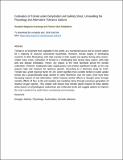| dc.description.abstract | Tomato is an important fruit vegetable in the world, as a nutritional source and an income option for a majority of resource constrained households. However, tomato supply in developing countries is often fluctuating, with high scarcity in both supply and quality during rainy season. Unlike many crops, cultivation of tomato is a challenging task during rainy season, with high pest and disease infestation. Hence, dry season is the most favorable period for tomato cultivation. However, inadequate water supply poses a yet another significant hurdle, as the crop requires high soil moisture for optimum growth. According to a landmark study by FAO, Tomato has a yield response factor of 1.05, which signifies that a smaller decline in water uptake results into a proportionally larger decline in yield. Moreover, over the years, there have been increasing reports of soil salinization, which imposes similar effects to drought stress through osmotic effects of Na+ in the soil solution and oxidative stress through excessive generation of reactive oxygen species. This chapter will dissect how tomato plants respond to these abiotic stress factors on physiological, anatomical, and molecular levels and suggest options to improve the crop’s productivity under these constraining environments. | en_US |

